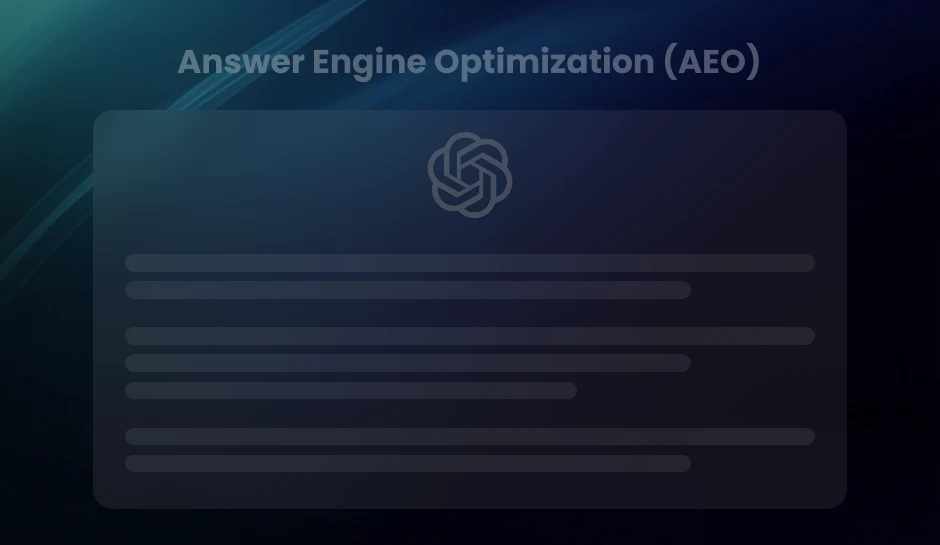
How AI in Google Analytics is Changing Data-Driven Decision Making
AI is redefining how businesses use Google Analytics, shifting from manual data interpretation to automated insights and predictive analytics. With AI-driven features in GA4, businesses can make faster, more accurate decisions, optimize marketing efforts, and stay ahead in an increasingly competitive landscape. Read on.
Data-driven decision-making has always been at the core of business success, but traditional analytics often fails to deliver real-time, actionable insights. Businesses have relied on manual data interpretation, historical trends, and intuition to shape their strategies. However, these conventional methods are no longer enough with increasing data complexity and customer expectations.
This is where AI in Google Analytics is making a significant impact. AI is shifting analytics from reactive reporting to proactive intelligence, helping businesses move beyond just tracking metrics to predicting outcomes and automating insights. Instead of sifting through endless reports, decision-makers can now rely on AI to detect patterns, forecast trends, and highlight critical business shifts, without manual intervention.
In this blog, we will explore how AI in Google Analytics revolutionizes data-driven decision-making, the key AI-powered features that enhance business strategies, and the future for AI-driven analytics.
The Role of AI in Google Analytics
AI is changing the way businesses analyze and act on data. Instead of spending hours manually sorting through reports, decision-makers now have AI handling the heavy lifting. It processes massive datasets in seconds, identifying patterns and trends that would take human analysts much longer to detect. This speed and accuracy give businesses a competitive edge, helping them make faster, data-driven decisions without second-guessing their strategies.
From Looking Back to Looking Ahead
Traditional Google Analytics focused on historical reporting—what happened, when it happened, and where traffic came from. While this data is useful, it does not tell businesses what will happen next. That is where AI takes things a step further.
With predictive analytics, Google Analytics can now forecast future trends. AI can predict which users are most likely to convert, which customers are at risk of leaving, and how revenue might fluctuate. Instead of reacting to changes after they happen, businesses can be proactive—adjusting marketing efforts, personalizing campaigns, and improving user experiences before they even notice a decline.
No More Guesswork—Just Actionable Insights
AI in Google Analytics does not just crunch numbers; it tells businesses what matters. It automatically detects unusual spikes in traffic, sudden drops in conversions, or shifts in customer behavior. Instead of relying on gut instinct, businesses get real-time alerts and clear recommendations on what to do next.
For example, if an e-commerce site experiences a dip in sales, AI can pinpoint whether the issue is due to slower site speed, a sudden drop in ad performance, or a change in customer preferences. This means businesses can fix problems before they snowball, leading to better decision-making, stronger strategies, and ultimately, higher revenue.
AI is turning Google Analytics into a decision-making powerhouse, helping businesses move beyond basic reports to real-time, intelligent, and predictive insights.
AI-Driven Features of GA4: The Seven Most Impactful Upgrades
Google Analytics 4 is no longer just a tool for reporting website traffic. GA4 helps businesses make data-backed decisions faster and more efficiently with AI-powered automation, predictive analytics, and real-time insights. Instead of sifting through endless reports, AI in GA4 highlights what truly matters, allowing businesses to focus on strategy instead of manual data analysis.
Here are the seven AI-driven features that make GA4 a game-changer for data-driven decision-making.
1. Predictive Analytics: Anticipating User Behavior Before It Happens
GA4 moves beyond historical data by predicting future user behavior. AI analyzes existing trends to provide businesses with insights such as purchase probability, churn likelihood, and revenue forecasting.
For example, if AI detects that certain users have a high churn probability, businesses can deploy retention campaigns to prevent customer loss. This helps optimize marketing budgets and improve return on investment.
2. Automated Insights: No More Manual Data Analysis
GA4’s AI automatically identifies trends, anomalies, and opportunities, reducing the need for manual data deep dives. The system highlights traffic spikes or drops, unexpected changes in conversion rates, and user engagement trends.
For instance, if a viral social media post suddenly drives massive traffic, GA4 will instantly notify marketers, enabling them to adjust campaigns in real time.
3. Smart Audience Segmentation: Reaching the Right People at the Right Time
Instead of relying on static audience groups, GA4 uses AI-powered segmentation to create dynamic, behavior-based audiences. This allows businesses to automatically identify high-value users, segment audiences based on real-time behavior and predicted actions, and deliver personalized marketing campaigns for better engagement.
For example, an ecommerce brand can detect users who abandoned their carts but are likely to return and target them with personalized discount offers, increasing conversions without additional ad spend.
4. Anomaly Detection: Spotting Issues Before They Become Costly
GA4’s AI continuously monitors website traffic, conversions, and engagement patterns. If an unexpected deviation occurs, whether a drop in conversions or a sudden traffic surge, GA4 immediately flags it for further analysis.
For example, if an online store experiences a thirty percent drop in checkout completions, GA4 can alert the business, helping them quickly diagnose and fix issues like technical errors, pricing changes, or external market shifts.
This feature ensures businesses respond to problems in real time, preventing revenue loss.
5. AI-Powered Personalization: Creating Tailored User Experiences
GA4’s AI analyzes browsing habits, purchase history, and engagement levels to personalize user experiences. It helps businesses recommend relevant products or content, optimize website experiences by dynamically adjusting elements, and deliver highly targeted ads that increase conversion rates.
For instance, if a user frequently browses running shoes, GA4’s AI can ensure they see related ads, email offers, or website recommendations, boosting engagement and increasing sales.
6. Real-Time Analytics: Making Data-Driven Decisions Instantly
GA4 provides AI-driven real-time analytics, enabling businesses to track live user activity, campaign performance, and traffic fluctuations. It allows marketers to adjust strategies based on immediate insights, ensuring optimized promotions and inventory management.
For example, an ecommerce brand running a flash sale can monitor user behavior in real time and adjust pricing, promotions, or stock allocation to maximize sales while reducing inventory risks.
7. Google Ads Integration: Smarter Campaign Optimization with AI
GA4’s AI-powered integration with Google Ads ensures businesses maximize their advertising budget by automatically adjusting bids to target high-value users, refining audience targeting using AI-driven segmentation, and optimizing ad spend based on conversion probability.
For example, instead of manually adjusting bids, AI automates the process by allocating ad spend where it will generate the highest return on investment, making advertising more effective and cost-efficient.
Pro Tip- GA4’s AI-driven capabilities do not just report data, they actively improve business performance by predicting future trends and user behavior, automating insights and eliminating manual reporting, enhancing personalization and audience targeting, optimizing ad spend for higher returns, and detecting problems before they impact revenue.
Practical Use Cases of AI in Google Analytics
Artificial intelligence is transforming data analytics, enabling businesses to extract valuable insights, automate decision-making, and improve performance. Google Analytics integrates AI to help businesses predict trends, understand customer behavior, and optimize marketing strategies. Here are key industry-specific applications.
E-Commerce: Predicting Customer Purchase Intent and Optimizing Recommendations
AI enhances e-commerce analytics by identifying buying patterns, predicting customer intent, and personalizing shopping experiences. Businesses use AI-powered insights in Google Analytics to achieve the following.
- Purchase Intent Prediction: AI analyzes browsing behavior, time spent on pages, cart activity, and past purchases to predict which users are most likely to buy. This helps businesses prioritize high-intent customers.
- Dynamic Product Recommendations: AI-driven models suggest relevant products based on user behavior, increasing the chances of conversions. Google Analytics integrates with machine learning algorithms to refine recommendations in real time.
- Cart Abandonment Reduction: AI identifies users who leave items in their cart and triggers automated email reminders, targeted ads, or special discounts to bring them back.
- Optimized Pricing Strategies: By analyzing demand trends and competitor pricing, AI helps businesses adjust prices dynamically to maximize revenue.
SaaS and B2B: Identifying High-Value Leads and Improving Conversion Rates
AI helps SaaS and B2B companies focus on leads with the highest potential, allowing sales and marketing teams to make data-driven decisions. AI-powered Google Analytics improves lead generation and conversion in the following ways.
- Lead Scoring and Qualification: AI assigns lead scores based on behavior, such as time spent on product pages, interaction with demo requests, and email engagement. This helps prioritize high-value prospects.
- Behavioral Segmentation: AI clusters leads into different segments based on their engagement level, allowing businesses to create personalized outreach campaigns.
- Predictive Analytics for Sales Teams: AI forecasts which leads are most likely to convert, helping sales teams allocate resources more efficiently and increase conversion rates.
- Automated Funnel Optimization: AI detects drop-offs in the sales funnel and provides insights into why users disengage, helping businesses refine their marketing and sales strategies.
Content and Media: Enhancing Audience Engagement and Content Performance
AI-powered Google Analytics helps content creators, publishers, and media companies understand what resonates with their audience, optimizing content strategies for better engagement. AI improves content performance in the following ways.
- Engagement Prediction: AI analyzes past user interactions to determine which types of content, including articles, videos, and infographics, drive the most engagement and conversions.
- Personalized Content Recommendations: AI dynamically suggests articles, videos, or related content based on a user’s browsing history, increasing retention and page views.
- Drop-Off Analysis: AI identifies where users abandon content, whether it is a video, blog post, or landing page, allowing businesses to refine content for better retention.
- Sentiment Analysis and Audience Insights: AI processes user feedback, comments, and engagement signals to determine audience sentiment and preferences, guiding content creation.
Pro Tip- To get the best results, integrate your AI tools with Google Analytics from the start. This will help you spot trends early, personalize user experiences, and take action quickly, giving you a competitive edge in optimizing conversions and engagement.
Integrating Google Analytics with Other Tools
Seamless Integration of GA4 with Google Ads
Google Analytics 4 (GA4) integrates seamlessly with Google Ads, allowing businesses to track user interactions, measure campaign success, and optimize marketing strategies. By leveraging GA4’s event-based tracking, marketers gain a data-driven approach to audience targeting and conversion tracking.
- Conversion Tracking: GA4 links event data with Google Ads, capturing key interactions such as purchases, sign-ups, and button clicks. This enables businesses to assess the effectiveness of their ad campaigns.
- Audience Creation: GA4’s AI-powered insights help build predictive audiences that sync with Google Ads for improved remarketing and customer targeting.
- Campaign Optimization: Marketers use GA4’s engagement metrics to fine-tune bidding strategies, optimize ad placements, and maximize return on investment (ROI).
- Cross-Device Tracking: GA4 unifies data across multiple devices and sessions, providing a comprehensive view of user behavior.
To integrate GA4 with Google Ads, link both accounts through Google Analytics Admin settings. Enable auto-tagging to ensure accurate data transfer and measurement.
Integrating GA4 with Other Marketing and Analysis Tools
GA4 extends beyond Google Ads, offering integrations with Google Tag Manager (GTM), BigQuery, Google Looker Studio, and third-party Customer Relationship Management (CRM) platforms. These integrations enhance data collection, visualization, and decision-making.
- Google Tag Manager (GTM): Simplifies GA4 event tracking by enabling tag-based implementation, reducing manual coding and improving tracking accuracy.
- BigQuery: Allows businesses to export GA4 data for advanced analysis, machine learning applications, and custom reporting.
- Google Looker Studio: Converts GA4 data into interactive dashboards, providing stakeholders with real-time insights.
- CRM Integrations: Platforms like HubSpot and Salesforce sync with GA4 to unify sales and marketing data, leading to improved customer segmentation and lead nurturing.
- Email Marketing Tools: GA4 integrates with Mailchimp, ActiveCampaign, and similar platforms to track user engagement from email campaigns to on-site activity.
DiGGrowth: An Advanced Alternative to GA4
While GA4 provides powerful analytics capabilities, platforms like DiGGrowth offer an AI-driven approach to marketing analytics. DiGGrowth enhances customer tracking, attribution modeling, and audience insights with automation and predictive intelligence. Unlike GA4, which requires multiple integrations, DiGGrowth provides a centralized dashboard that seamlessly integrates with various marketing and sales tools without extensive manual setup. Businesses looking for a more unified and AI-powered analytics solution can consider DiGGrowth as an alternative or complementary tool to GA4.
For successful integration, businesses should use GA4’s built-in connectivity features or set up API connections when required. Regularly validating data flow between tools ensures consistency and accurate reporting.
Key Takeaways
- AI in Google Analytics moves businesses from traditional reporting to predictive insights, enabling proactive decision-making.
- Automated insights eliminate the need for manual data analysis, allowing businesses to act on trends in real time.
- AI-powered segmentation helps create highly targeted marketing campaigns, improving engagement and conversion rates.
- Real-time anomaly detection ensures businesses can quickly respond to traffic drops, conversion issues, or customer behavior shifts.
- Seamless integration with marketing and analytics tools, including Google Ads and CRMs, enhances data accuracy and strategic execution.
Conclusion
AI in Google Analytics is changing the way businesses leverage data. Instead of relying on historical reports, companies now have access to predictive analytics, automated insights, and real-time intelligence. This shift allows businesses to make faster, more informed decisions, optimize marketing efforts, and improve customer experiences with minimal manual intervention.
For those looking to take their analytics to the next level, DiGGrowth offers a powerful AI-driven alternative, streamlining data analysis and providing deeper insights without the complexity of multiple integrations.
Want to optimize your data strategy with AI?
Contact us at info@diggrowth.com to explore the best solution for your business.
Ready to get started?
Increase your marketing ROI by 30% with custom dashboards & reports that present a clear picture of marketing effectiveness
Start Free Trial
Experience Premium Marketing Analytics At Budget-Friendly Pricing.

Learn how you can accurately measure return on marketing investment.
Additional Resources
Don’t Let AI Break Your Brand: What Every CMO Should Know
AI isn’t just another marketing tool. It’s changing...
Read full post postFrom Demos to Deployment: Why MCP Is the Foundation of Agentic AI
A quiet revolution is unfolding in AI. And...
Read full post postAnswer Engine Optimization (AEO): The New Frontier of SEO in 2025
As digital experiences continue to evolve, so does...
Read full post postFAQ's
AI predicts customer churn by analyzing behavioral patterns. Businesses can use these insights to create targeted retention campaigns, personalized offers, and proactive engagement strategies, reducing churn and improving customer loyalty.
Yes, AI identifies traffic sources, user behavior, and keyword trends. It detects content performance gaps, suggests optimization strategies, and helps businesses refine their SEO for better search visibility and engagement.
AI in GA4 uses privacy-centric tracking, anonymized data collection, and machine learning models that respect user consent. It helps businesses comply with regulations like GDPR while still providing valuable insights.
Yes, AI-driven insights help small businesses by automating data analysis, identifying growth opportunities, and optimizing marketing strategies. It reduces reliance on manual reporting, making data-driven decisions more accessible and efficient.
AI in GA4 provides real-time updates, continuously analyzing user interactions, traffic trends, and anomalies. Businesses receive automated alerts and recommendations whenever significant changes occur, enabling them to take timely action.


